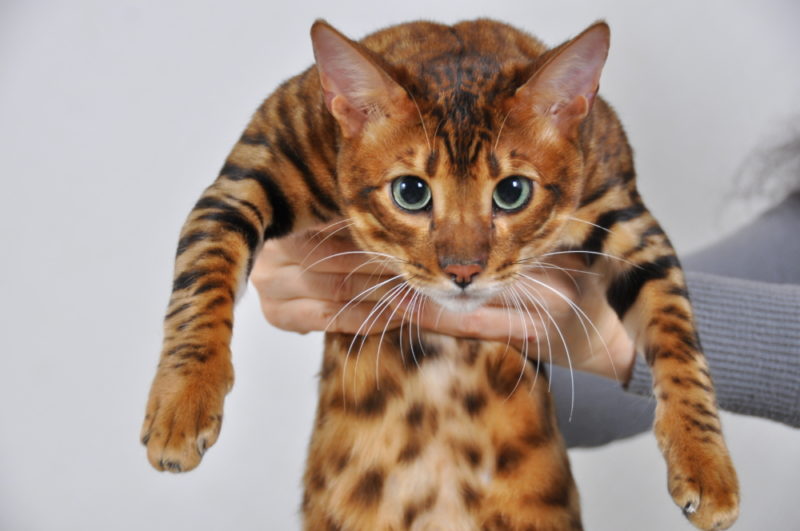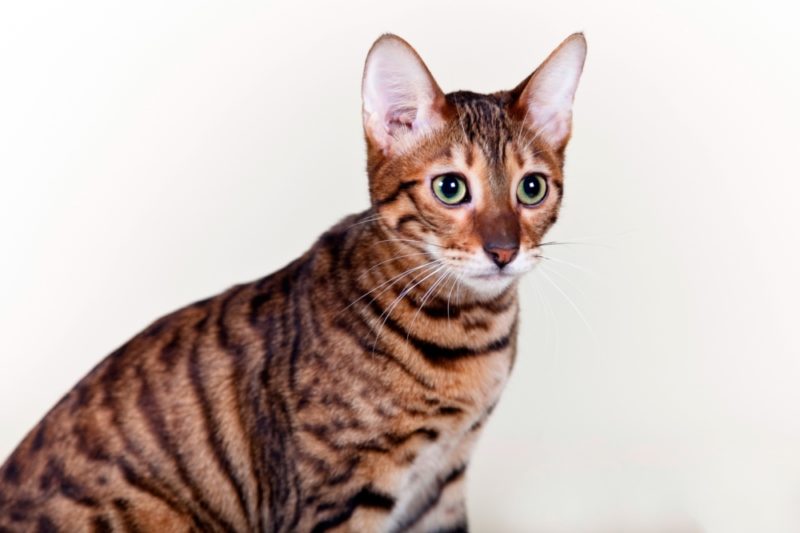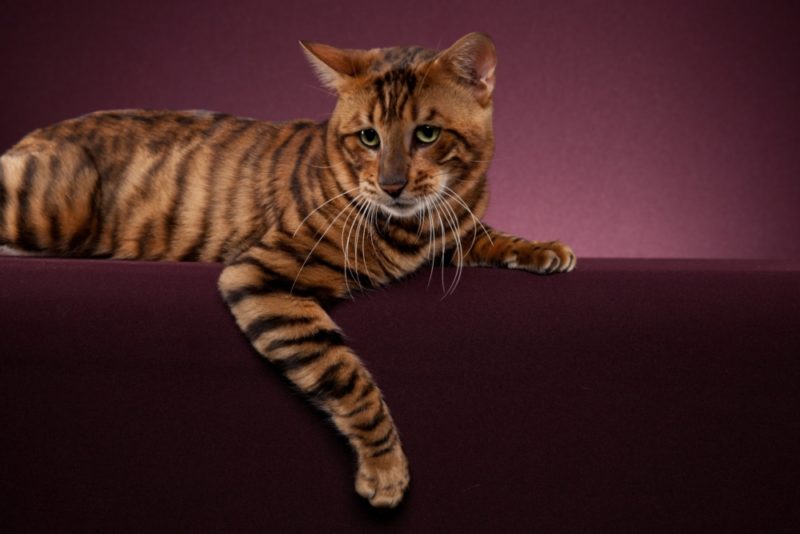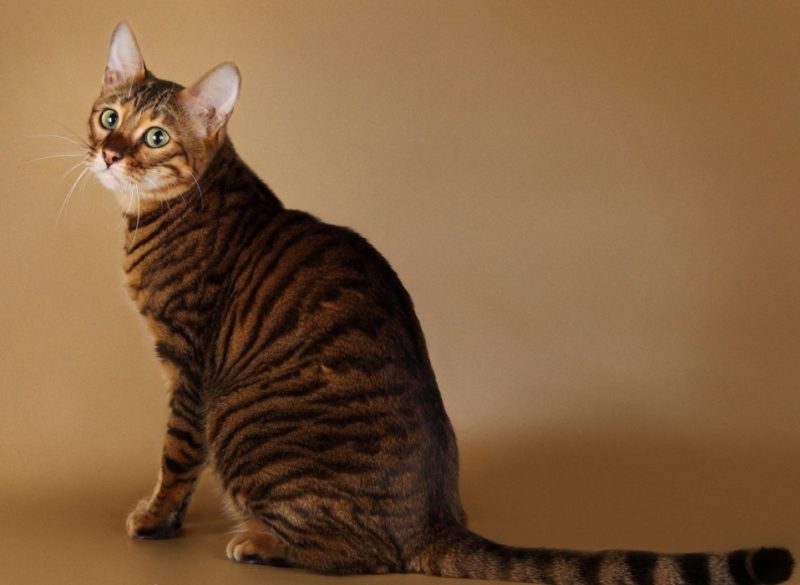Tiger cat is a combination of the beauty of a tiger and the soft nature of domestic cats. This is an unpretentious, strong, healthy long-liver, which is ideal as a family favorite.
Material Content:
Description and characteristics of the breed
Tiger stripes are on the fur of most cats. They are pronounced only in a small number of breeds. Toyger is one of the youngest representatives of striped cats. Toiger means not just a tiger, but a toy tiger. Therefore, the tiger is an incorrect name that has already spread.
Toyger is on the list of the most expensive and exotic breeds. It is believed that its presence in the house is one of the symbols of the owners' wealth and even their status.
Toiger was bred by crossing a Bengal cat with a yard ordinary cat. They “worked” on his appearance for a long time and continue to do it now. His recognizable color was determined in 2007. Parents were selected for a long time, so that these cats turned out to be really small copies of tigers.
A tiger cat has the following features:
- massive body weighing about 6-8 kg;
- different weights of females and males: cats - 3-5 kg, cats - 5-7 kg;
- high shoulders;
- strong wide bones;
- short, silky coat;
- short and long tail, at the end rounded;
- strong neck;
- paws are medium;
- hind legs are longer than forepaws, which helps cats to jump far and high;
- rather large wide nose, which is unusual for cats;
- muzzle slightly elongated, not round;
- large and round bright blue eyes (selectors try to reduce them);
- upper eyelids slightly lowered;
- ears are standard, slightly pointed, rather large (selectors aim to change the shape of the ears to a more rounded one).
The breed representatives have many positive qualities - they are smart, affectionate, very mobile, playful, but at the same time they maintain a characteristic inner calm. With all the playfulness, they rarely run around the house. More often they rest majestically, taking caresses. Rarely show aggression to humans. This is an independent proud animal. And yet it is one of the most friendly and affectionate tiger breeds. Cats are mobile at night, are jumping. In the afternoon they like to get out on a hill.
Toigers are safe for children and enjoy playing with them. They do not get attached painfully, they are not sad without company, they know how to enjoy both communication and loneliness. “Toy tigers” communicate well with other species of animals, do not compete, are not jealous. He has enough small area for games. Life expectancy of individuals is up to 20 years.
Cats adapt perfectly to the new environment. They quickly remember where the tray and the container with food and water are, using these items carefully. Caring for them does not take a lot of time, but playing with them is still worth it. In adulthood, these cats are very loyal. Nevertheless, it is important to consider that all cats have their own character. Behavior, interests, hobbies can be very different. These animals swim well. Water is not afraid. They like bathing procedures and swimming very much.
Individuals have a funny language: they not only make famous cat sounds to everyone, but they can “sing” like birds. But this is a quiet breed that "communicates" affectionately and unobtrusively.
Origin history
The story of this feline begins in the 1980s. The author of the idea of such a symbiosis and the official founder is a resident of America, Judy Sagden. The breeder decided to improve the quality of the color of the tabby mackerel, to achieve greater brightness, similarity with the color of the tiger. The American noticed that her cat has 2 tabby spots on her temples. This is usually not the case with tabby individuals. Judy brought an ordinary domestic short-haired cat with a large Bengal for the experiment. The kitten then born became the progenitor of the entire breed. Judy Sagden admitted that the purpose of the appearance of the breed is to draw people's attention to the conservation of the population of wild tigers. Presented by Toyger for the first time in 2006. A year later, the new breed was officially recognized by the International Cat Association. In that year, the breed received permission to participate in exhibition competitions.
Color tiger cat
The "fur coat" is golden with pronounced stripes of various shapes and lengths. The color of the stripes is diverse - from black to brown, red, dark red. Bottom of the legs are “painted” in a dense black color, like the tip of the tail. Eyes as if surrounded by light paint, creating the effect of wearing glasses.
The wool pattern includes not only strips, but also sockets, small spots. Thanks to this toyger is a bit like a jaguar. Such a pattern is especially noticeable on the back, a little less on the muzzle. Stripes cross the body vertically, but very unevenly. These "strokes" are connected on the limbs, tail, neck. It is worth considering patterns on wool, because they are always vitiate and unique for each individual.
The color standard is the maximum contrast of the colors of different parts of the body. For example, the contrast of the colors of the back and abdomen, the inner and outer surfaces of the ears, stripes and background. The hair is pigmented along the entire length - from the skin to the very tip.
Content Features
Toyger breed feels good in conditions of large or very small housing, does not require a large area. Cats are sometimes lazy. If this lasts a long time, you can stimulate the pet to play. But you should not be intrusive, because the breed loves peace. Cats will definitely jump, climb hills. For them, special houses, tunnels, stairs are purchased. In general, the breed is unpretentious.
Care, health and nutrition
Mandatory procedures are standard. It is necessary to regularly comb out the “fur coat” once a week, rinse thoroughly with ears, eyes, brush teeth, and cut off overgrown claws. Often there is no need to bathe a pet. This is done as the fur becomes dirty. Be sure to purchase a claw tip, because the claws of the breed are sharp and large.
There is an opinion that individuals during the breeding process lost their natural ability to find a trace and return home. Therefore, it is worthwhile to carefully monitor that the domestic tiger cat is not lost. It is better to use a collar with an address and a bell.
Two meals a day with the highest quality dry food are suitable. But we must not forget about natural top dressing in the form of offal (pork, veal hearts), skinless chicken breasts. Feeding “human” food is not worth it. It is also dangerous to give fish.
Due to the tight control of breeding, these cats do not suffer from allergies, dysbiosis. They calmly tolerate vaccination.
Breeding
Pregnancy and childbirth are rarely accompanied by difficulties. The number of individuals in the litter is not more than 5. Toygers are bred exclusively in nurseries. There they should be bought, requiring the provision of documents. Nurseries that breed according to the principles of Judy Sagden give babies only after sterilization. At home, this breed is not bred. This made its representatives such strong, healthy long-livers. All kittens must undergo a routine examination, after which there is no doubt about the breed. If the breeder gives his cat “in good hands”, you should not trust. It is always important to check for permissions and other documents.
Typical breed diseases
The breed of cats similar to a tiger is represented by strong, healthy animals with high immunity. But they are susceptible to certain diseases. First of all, heart diseases are quite common among them. Especially dangerous for them are infectious peritonitis, hypertrophic cardiomyopathy. Many tigers are overweight. Nutrition should be controlled - the quantity and quality of feed. With the right diet and a quiet comfortable life with mandatory checks at the veterinarian, the cat will live a long life (average 15 years). Hereditary diseases in this young breed have not yet been discovered.
Toyger is one of the most “family” tiger breeds. Majesty in behavior, noble color and affectionate character made her very popular in the world.
















